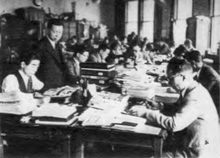Tokyo Metropolitan Police Department
This article needs additional citations for verification. (August 2008) |
Coordinates: 35°40′37.3″N 139°45′8.3″E / 35.677028°N 139.752306°E
| Tokyo Metropolitan Police Department 警視庁 Keishichō | |
|---|---|
 Asahikage | |
 Headquarters building | |
| Abbreviation | TMPD |
| Agency overview | |
| Formed | 1874 |
| Jurisdictional structure | |
| Operations jurisdiction | Tokyo, Kantō region, Japan |
| Governing body | Tokyo Metropolitan Government |
| General nature |
|
| Operational structure | |
| Overviewed by | Tokyo Metropolitan Public Safety Commission |
| Headquarters | 1-1 Kasumigaseki 2-chome, Chiyoda-ku, Tokyo 100-8929 |
| Sworns | 43,566 |
| Police Administrative Civilians | 3,015 |
| Agency executives |
|
| Bureaus | show
6 |
| Facilities | |
| Stations | 102 |
| Patrol Cars | 1292 |
| Motorcycles | 958 |
| Security boats | 22 |
| Helicopters | 14 |
| Dogs | 36 |
| Horses | 16 |
| Website | |
| Tokyo Metropolitan Police Department (in Japanese) Tokyo Metropolitan Police Department (in English) | |


The Tokyo Metropolitan Police Department (TMPD) (警視庁, Keishichō) serves as the prefectural police department of Tokyo Metropolis. Founded in 1874, it is headed by a Superintendent-General, who is appointed by the National Public Safety Commission, and approved by the Prime Minister.
The Tokyo Metropolitan Police Department, with a staff of more than 40,000 police officers, and over 2,800 civilian personnel, manages 102 stations in the prefecture.[1]
The main building of the Tokyo Metropolitan Police Department is located in the Kasumigaseki, Chiyoda ward, Tokyo. Built in 1980, it is 18 stories tall, a large wedge-shaped building with a cylindrical tower. It is easily seen from the street and a well-known landmark.
The HQ building is located in Sakurada Gate, so it is also metonymically called "Sakurada Gate".[2]
History[]
To prepare for the G20 summit in 2019, the TMPD announced the establishment of the Water Response Team in order to police bodies of water near G20 summit venues.[3]
Scandals[]
In 1978, the TMPD was investigated when a uniformed officer killed a female university student inside her residence.[4] In 1997, an officer was caught for making up information in an amphetamine case.[4]
In 2007, the TMPD was under scrutiny when a serving TMPD officer was involved in an incident where he used his official sidearm to shoot a female person to death before he committed suicide.[4] The TMPD was investigating an incident in the Kamata Police Station in Ota Ward where a police officer committed suicide in February 2014 due to harassment at work. The chief in charge was disciplined.[5]
Organization[]
The TMPD is under the command of a Superintendent-General and reports directly to the Tokyo Metropolitan Public Safety Commission. The Superintendent-General can be appointed and replaced at any time as long as the prime minister and the TMPSC receives their approval.[6]
Since the TMPD is autonomous, it does not operate under the authority of any Regional Police Bureau.[7]
The TMPD has nine bureaus that report to the Deputy Superintendent General:[1]
- Administration Bureau (総務部)
- Personnel and Training Bureau (警務部)
- Traffic Bureau (交通部)
- Community Police Affairs Bureau (地域部)
- Security Bureau (警備部)
- Public Security Bureau (公安部)
- Criminal Investigation Bureau (刑事部)
- Community Safety Bureau (生活安全部)
- Organized Crime Control Bureau (組織犯罪対策部)
The TMPD also has its own academy, the Metropolitan Police Department Academy.
Ranks and insignia[]
The ranks used in the TMPD have been slightly revised in 2013, changing only the English translation of some of the ranks used by the force.[1]
Otherwise, these ranks are observed throughout its history.[8]
- Superintendent-General (four gold rising suns)
- Deputy Superintendent-General (not rank, but post of TMPD. gold-wreathed gold emblem with three gold bars)[a]
- Senior Commissioner (gold-wreathed gold emblem with three gold bars), formerly Superintendent Supervisor[b]
- Commissioner (gold-wreathed gold emblem with two gold bars), formerly Chief Superintendent[b]
- Assistant Commissioner (gold-wreathed gold emblem with one gold bar), formerly Senior Superintendent[b]
- Superintendent (gold-wreathed silver emblem with three gold bars)
- Chief Inspector (gold-wreathed silver emblem with two gold bars), formerly Inspector[b]
- Inspector (gold-wreathed silver emblem with one gold bar), formerly Assistant Inspector[b]
- Sergeant (silver-wreathed silver emblem with three gold bars)
- Senior Police Officer (silver-wreathed silver emblem with two gold bars)
- Police Officer (silver-wreathed silver emblem with one gold bar)
Gallery[]

Metropolitan Police HQ
Metropolitan Police HQ seen from the Tokyo Imperial Palace

Hayabusa helicopter (AgustaWestland AW109E, JA34MP)

Uniformed officer

The Emergency Response Team (ERT)
See also[]
Notes[]
References[]
- ^ Jump up to: a b c TMPD. "2019 Tokyo Metropolitan Police Department" (PDF). p. 34.
- ^ 霞が関、桜田門、兜町...「別の意味」でも使われる東京の地名 - Money post web(01/14/2020)
- ^ "東京五輪警備へ初の対テロ部隊 警視庁". Sankei Shimbun (in Japanese). 13 May 2019.
- ^ Jump up to: a b c "Top Tokyo cop reprimanded for alleged murder by officer". The Japan Times. Kyodo News. 21 September 2007.
- ^ Clegg, Cara (23 April 2014). "'Power harrassment [sic]' in Japan's police force blamed for officer's suicide". SoraNews24.
- ^ "The Present Police Organizations of Japan and the Philippines" (PDF). Retrieved 2019-05-13.
- ^ Nakahara, Hidenori (1956). "The Japanese Police" (PDF). scholarlycommons.law.northwestern.edu. Retrieved 2019-05-13.
- ^ "The Police of Japan" (PDF). National Police Agency of Japan. 1982. Retrieved 2019-05-13 – via National Criminal Justice Reference Service.
- ^ Metropolitan Police Department, police stations Archived 2014-08-03 at the Wayback Machine, Ogasawara Archived 2014-10-02 at the Wayback Machine: 管内の概況 Archived 2014-08-09 at the Wayback Machine
External links[]
| Wikimedia Commons has media related to Metropolitan Police Department (Tokyo). |
- Tokyo Metropolitan Police Department (in Japanese)
- Tokyo Metropolitan Police Department (in English)
- Tokyo Metropolitan Police Department
- Government of Tokyo
- Prefectural police of Japan
- 1874 establishments in Japan
- Organizations established in 1874








